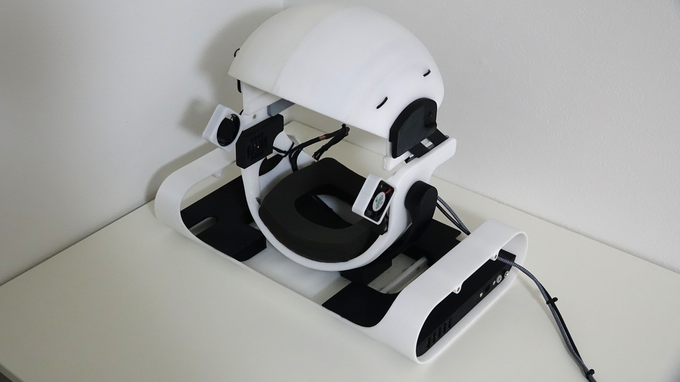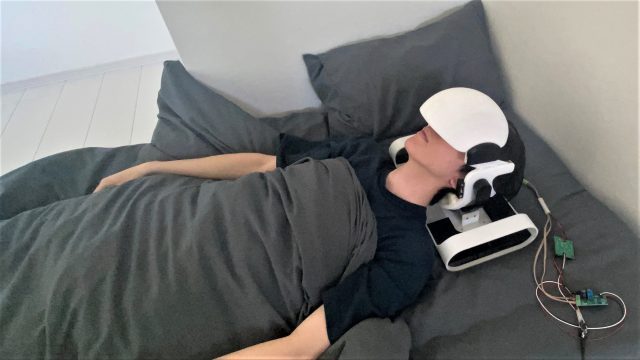Japanese startup Diver-X launched a Kickstarter for a unique VR headset called HalfDive that was designed to be used while laying down, drawing some pretty clear inspiration from hit anime Sword Art Online. Although the unique project managed to secure enough cash to be considered fully funded, the team has decided to cancel the Kickstarter, citing scaling issues which ultimately stem from its niche appeal.
Diver-X announced that it’s pulling the plug on HalfDive, announcing that all backers would not be charged for funds collected.
The company mentions three major concerns, which essentially boil down to its niche appeal, inability to reduce costs by producing major components in-house, and resultant cash flow issues due to scalability issues. You can read the full text in the company’s blog post.
“We were faced with the brutal reality that no matter how optimized and multifunctional our device may be for use in sleeping-posture, it is only a replacement of existing VR devices and not yet an interface that brings innovative experiences,” Diver-X says.
Despite the setback, the company maintains it’s still dedicated to developing “full dive” tech which emphasizes in-bed VR immersion. The original article announcing the campaign’s start follows below:
HalfDive has just surpassed its funding goal, amassing around $178,000 from 177 backers. All available funding tiers are still available at the time of this writing, with the most popular tier, the early bird Basic Model, having nearly sold out at $1050.
Diver-X hasn’t published stretch goals yet, however we’ll be following the project as it finishes out the remained of its 40 days until the campaign comes to an end on January 30th, 2022. The original article detailing the Kickstarter follows below:
Original Article (December 16th, 2021): HalfDive isn’t a brain-computer interface like SAO’s NerveGear, however it does promise to let users play SteamVR games like VRChat and experience some pretty interesting object interaction via its tethered force feedback solution too.
The Kickstarter launched today, and is asking for ¥20,000,000 or around $176,000 USD. At the time of this writing, the project has already garnered over $70,000, putting it around one-third of the way there.
Diver-X is offering two distinctive models through the Kickstarter, what it calls a ‘HalfDive Minimum Model’ (starting at $750) and ‘HalfDive Basic Model’ (starting at $1,050).
The minimum model includes the headset and base, a pair of HalfDive controllers, and a proprietary head tracker. The basic model includes that, plus the force feedback module and a pair of wind feedback modules (re: fans) for both greater immersion and cooling.


The company previously said it would be providing a more expensive version with variable focus lenses, however the creators say the variant is too difficult to mass produce. There won’t be a stretch goal for vari-focal lenses either, something Diver-X says they’ve decided as to better focus on development and production.
Controllers haven’t been revealed yet either. The creators are ostensibly still working on its promised foot-worn ankle controllers and the Vive Index-style hand controllers, which it teased in previous marketing material. Its force feedback cuffs appear to provide a place to attach Vive Trackers at least. The company says its working to integrate support for Tundra Trackers as well.
As for functionality: unlike standard VR headsets, which require you to strap them to your head for optimal fit and image clarity, HalfDive is more of a passive experience that seems to cradle your head rather than tightly affix it in place. Diver-X CEO Yamato Sakoda adjusts himself into a prone position and slips on two hand-worn cuffs that are tethered with retractable wires to force feedback modules in the base of the unit.
Diver-X says its design primarily allows users to operate in VR without any pressure on the head, and as a result covers 99% of all human head sizes.
As you’d imagine, a user laying on the ground has a different expected range of motion is than someone using a VR headset in either sitting or standing positions. The headset’s range of motion was previously described by Diver-X as 4.5 degrees of freedom (DOF), further calling it “virtual 6DOF”. We can see what that means functionally in the video of the 3D printed third prototype below as he adjusts the visor down into the optimal viewing position and angles it left and right, also called ‘yaw’.
What the gif doesn’t show is it can also apparently pitch up and down (relative to the user’s point of view) to a lesser degree. Still, that action looks pretty stiff, and even with the promise of a smoother injection molded body, looking around will decidedly require more effort than with a standard VR headset in either seated or standing position.
Construction of the mold for mass production is said to take place in February 2022, with completion estimated for May. Shipping is said to arrive sometime in Summer 2022; Kickstarter funding tiers are marked as releasing in August 2022.
It’s an innovative design for sure, however HalfDive is probably not for everyone. Playing VR games whilst laying down—but positioned in the VR world as if you’re standing up—may cause discomfort in some users depending on the amount of movement required in the game. Vection, or the motion that’s implied by movement in your visual field, can lead to discomfort if artificial motion and your body’s expectation of that motion don’t match up well enough.
That’s essentially why room-scale games without any type of artificial locomotion are usually the most comfortable to play, while games that toss around your point-of-view with topsy-turvy game geometry, or include heavy expectation of frenetic movement, are often the least comfortable among the bunch.
Granted, HalfDive looks pretty ideal for watching Netflix in the void theater, and maybe even hanging out in VRChat for a chill virtual face-to-face that doesn’t require too much virtual locomotion. We’re looking forward to seeing more as the headset exits its third prototype phase and heads closer to mass production in early Summer 2022. Again, you can check out the Kickstarter here.
Specs
- Display – 2,880 × 1,600 LCD at 90Hz (1,440 × 1,600 per eye)
- Optics – 10-element aspheric lens array
- FOV – estimated 134°
- Adjustable IPD – 58-84 mm range
- I/O – Located in headset base: DisplayPort 1.2 / USB3.0 / 3.5mm audio jack / 12V power source / I2C (module connection),
- Tracking – HalfDive tracker, Vive tracker supported (Tundra Tracker support coming soon),
- Audio – built-in 4-spear array, microphone
- Supported OS – Windows 10 (Linux support coming soon)
- Minimum PC specs – Dual Core CPU with hyper-threading, 8GB RAM, Nvidia GeForce GTX970 / AMD RX 480


